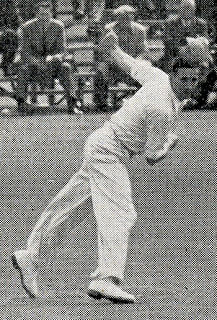
The A-Z of Derbyshire Cricket - J is for Jackson: Les Jackson

Les Jackson.
It has to be, doesn’t it? If you asked every Derbyshire supporter to name a greatest ever XI, I find it hard to believe anyone would omit him.
There were other good candidates among the J’s. His namesake Brian, who followed him into the Derbyshire side from league cricket, was himself a very good bowler and made up an outstanding opening attack with Harold Rhodes for a few seasons. There was also GR Jackson, a determined batsman and good captain who was largely responsible for bringing together the players of the 1936 Championship side.
Then there was Laurie Johnson, arguably the most entertaining batsman in the side from the early 1950s to mid-1960s. Born and brought up in the Caribbean, Johnson brought a range of untypical shots to the Derbyshire side in that period, all flowing drives and rapier cuts. His average may not have matched his talent, but Johnson was, by all accounts, a fine player to watch on the often rain-affected tracks that he and his generation played on.
Nor should we overlook the sterling efforts of Steffan Jones, nor the one season of brilliance that we saw from Dean Jones, a contender for the most complete all-round batsman we have seen at the club. Jones could dig in when the situation demanded, display all the shots that anyone could need and run like a whippet between wickets. Without doubt he was the best pacer and finisher of an innings I have seen in the club colours and he took the club closer to the Championship than anyone else in recent memory, as an aggressive captain who unfortunately managed to polarise a dressing room full of strong characters.
Yet, at the end of it all, there is Les. I’m not old enough to remember him in his pomp, but Dad’s eyes still mist over when he talks about him. We met him a couple of years before he died at the County Ground and it was the nearest I’ve seen my Dad to being tongue-tied in the presence of his hero. I still treasure a letter I got from him a few years earlier, when I wrote with a question, more in hope than expectation of an answer. Yet a reply was prompt, polite and much appreciated.
His figures speak for themselves. 1733 wickets at 17, twenty times taking ten in a match, 115 times taking five in an innings. You could talk for ten minutes about his greatest feats and not repeat yourself, but suffice to say that he was incomparable as a Derbyshire bowler. He might have made it as an international too, but the powers-that-be decided that Les wasn’t good enough, his action not aesthetically pleasing enough, for England, something that contradicted the opinion of the batsmen that faced him over fifteen years. Not bad for someone who was 26 before playing county cricket.
When they eventually brought him back in 1961, fourteen years after his one previous Test and at the age of 40, he let no one down. It is ironic that the Australians looked for his name in every England squad and were continually astonished that he was overlooked. Donald Bradman considered him the best bowler they faced in 1948, something that makes his subsequent omissions all the more startling. Les simply carried on bruising the ribs and fingers of batsmen year after year, as well as getting them out. In 1958 he took 143 wickets at under eleven runs each, despite cutting down his pace because of a bad groin injury, the sort that would have seen most men out for weeks.
Such things were of little consequence to him. Donald Carr once recounted, after finding Les in the dressing room with his sock and boot a mess of blood and pus from burst blisters, that he asked why he hadn’t said something. Les simply shrugged. “You asked me to bowl skipper, so I bowled”. Could any captain want for more from a bowler? When asked how he obtained such extravagant lift and movement he was typically modest. “I just wrap my fingers around the ball and bugger about with it until something happens”. It usually did.
I saw him play only once, at Queens Park for a match between a Derbyshire XI and the International Cavaliers in September 1968, one of the games that were a precursor to the John Player Sunday League that started the following year. In the opposition were Geoff Boycott, Barry Richards, Ted Dexter, Mike Smith and Fred Goldstein, a South African opener who hit the ball with real power and played for Oxford University and Northamptonshire for a while. It was serious opposition – and Les was 47 years old and had been retired for five years.
He had Boycott and Goldstein lbw and finished with 9-1-19-2. Not bad for an old timer, but no real surprise.
In the context of Derbyshire cricket, Les was one of the golden greats.